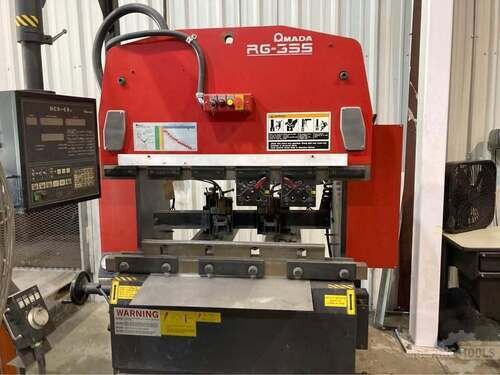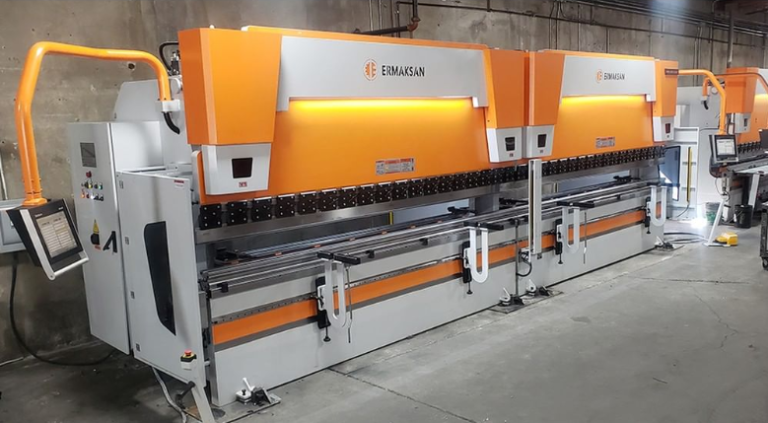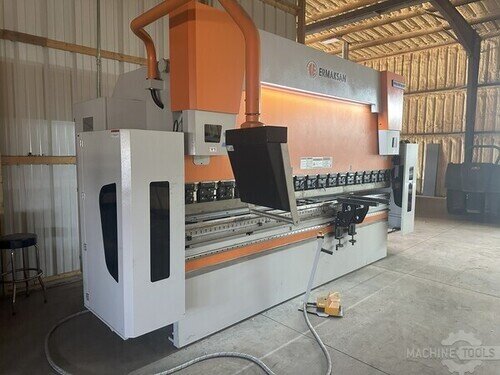Big bends are strategic. They determine whether you weld three pieces together or ship one high-value part on time with the flatness, angle accuracy, and appearance your customers expect. As President of Mac-Tech, I help fabricators weigh investments that move the needle on throughput, first-pass yield, and cash flow. Ermaksan tandem press brakes give you precision at scale, and Section 179 provides a timely financial lever to accelerate the business case before year end.
Strategic Upside in Precision Big Bends with Ermaksan Tandem Press Brakes
Large-format bending creates more than just oversized parts. It shortens downstream steps, reduces weld seams, and unlocks new quoting opportunities in construction components, heavy equipment, trailers, energy, and architectural metals. Tandem press brakes combine two synchronized machines into one flexible system for long parts, while retaining the option to run each machine independently for daily work.
Ermaksan tandem setups deliver consistent angles over long distances by synchronizing both frames, rams, and backgauges through a single CNC. The result is linear accuracy across the full length and stable repeatability over long production runs. When the long jobs are done, switching to independent mode turns the same footprint into two productive brakes.
The strategic gain is resilience. During big projects, tandem mode keeps you competitive on capability and delivery. During routine weeks, independent mode keeps operators busy and margins healthy without carrying idle iron.
Financial Outcomes that Matter: ROI, CapEx timing, and Section 179 acceleration
The ROI drivers are clear. Tandem bending reduces weld hours, rework, and fit-up time because you eliminate joints and shrink cumulative angle error. Precision bending reduces scrap and first-part prove-out. Combined with offline programming and fast tool swaps, your quoted cycle times move down and on-time delivery goes up.
CapEx timing matters. Section 179 can allow businesses to expense qualifying equipment that is purchased and placed in service within the tax year, subject to annual caps, phase-outs, and taxable income limits. Bonus depreciation may further accelerate deductions where applicable. Rules change, so confirm current limits and eligibility with your tax advisor.
Financing aligns cash flow with tax benefits. Many clients structure low upfront payments with the goal of placing equipment in service before year end to capture Section 179. The combination of immediate tax acceleration, early productivity gains, and stable payments often creates a faster payback and reduces risk in the first production quarters.
Precision at Scale: Synchronized axes, adaptive crowning, and real-time angle control for first-pass yield
Ermaksan tandem systems synchronize Y1 and Y2 servo-hydraulic axes on each machine, then coordinate both brakes through the CNC so ram movement tracks to microns using high-resolution linear scales. That keeps angles consistent along the entire bend line, not just at the ram center, even on challenging materials and long parts.
Adaptive crowning compensates for bed and ram deflection. The CNC calculates crowning across the full length and applies the right correction as tonnage changes, material thickness varies, or a new bend sequence changes load profiles. This is essential for long parts where small deflection becomes large angle drift at the ends.
Optional real-time angle measurement uses laser or contact systems to read the current angle during the bend. The CNC then adjusts depth in the same cycle to hit the target without chasing springback across multiple test parts. First-pass yield goes up and operators gain confidence to run long parts with fewer checks.
Throughput Levers for Large Parts: Offline programming, rapid tooling, and automated handling
Offline programming with Delem or ESA software lets your team simulate bends, check collisions, and optimize sequences before a single sheet is moved. Backgauge positions, bend order, and crowning maps are all validated upfront, which keeps the cell cutting and bending rather than waiting on programming.
Rapid tooling matters once you get to the floor. Hydraulic quick-clamping and standardized precision tool systems reduce setup time between long-part runs and daily work. Consistent tool libraries across both brakes ensure tandem programs run as expected when the machines are linked.
Automated handling options extend throughput for heavy and large sheets. Sheet followers, front supports, synchronized backgauge supports, and coordinated crane or lift-assist plans reduce operator burden and improve safety. For higher volumes, robots or gantry-style handlers can be integrated to stage and remove parts while the tandem cell continues bending.
1990 Accurpress 7606
- Capacity: 60 T x 72″
- Weight: 6,000 lbs.
- Dimensions: 84″L x 40″W x 70″ H
- Ram stroke: 8″
1992 Accurpress 750024
Operational Risk and Workforce Strategy: Safer cells, tighter footprints, and better labor utilization
Two synchronized brakes provide redundancy. When a long-part job ends, each machine can run independently to keep operators productive. If one brake is down for maintenance, the other still produces. This flexibility reduces single-point risk that often comes with a single oversized machine.
Safety features include light curtains, area scanners, and laser protection devices that work in tandem mode and independent mode. Ergonomic sheet followers and supports reduce strain, which broadens the pool of operators who can run oversized parts safely and confidently.
A tandem footprint is practical. You gain long-part capability without committing to the space and cost of a custom extra-long frame. That supports better layout density, shorter material travel, and improved flow from laser to brake to weld or assembly.
The Mac-Tech Growth Platform: Integration, financing, analytics, and lifecycle support for long-term value
Mac-Tech does more than ship machines. We design the cell around your parts, from power and air planning to floor layout, rigging, and safety. Our team configures the CNC, offline software, backgauge axes, crowning strategy, and tool libraries so you hit the ground running on day one.
We tailor financing for tax strategy and cash flow, including structures that align with Section 179 goals. Whether you prefer a $1 buyout or FMV lease, we map payment timing to installation, training, and ramp to production. Our network helps accelerate approvals and stay ahead of year-end deadlines.
Analytics close the loop. We connect machine data where available to OEE dashboards and production reporting so leaders can see utilization, queue times, and first-pass yield. Lifecycle support covers preventive maintenance, emergency service, remote diagnostics, and operator training. As your mix evolves, we help with tooling, software updates, and expansion plans so the tandem cell remains a growth asset.
FAQ
Where does a tandem press brake outperform a single extra-long machine?
When you need long-part capacity plus day-to-day flexibility. Tandem mode covers big bends, then independent mode keeps two teams productive on standard work, which improves asset utilization and reduces risk.
How do Section 179 deductions work with financed equipment?
If the equipment qualifies and is placed in service within the tax year, many businesses can take the deduction even when financing. The deduction, combined with early productivity gains, can offset a significant portion of first-year payments. Confirm eligibility and limits with your tax advisor.
What is required for “placed in service” by year end?
The equipment must be installed, connected, tested, and ready for its intended use. We coordinate delivery, rigging, training, and run-off to help meet your timeline, then provide documentation for your records.
Will our existing tooling and programs transfer to Ermaksan?
In many cases, yes. Hydraulic quick-clamping accepts common precision tool systems, and offline software can import part data for reprogramming. We validate tooling compatibility and convert programs where needed during commissioning.
What automation options provide the fastest payback for large parts?
Start with sheet followers, front supports, and lift assists. They cut labor and reduce defects with modest investment. For higher volumes, consider coordinated robots or gantries that stage and remove parts while both brakes maintain cycle time.
If you would like to discuss an Ermaksan tandem plan, reach me directly. I am Joe Ryan, President of Mac-Tech, joe@mac-tech.com, 414-477-8772.
Get Weekly Mac-Tech News & Updates








